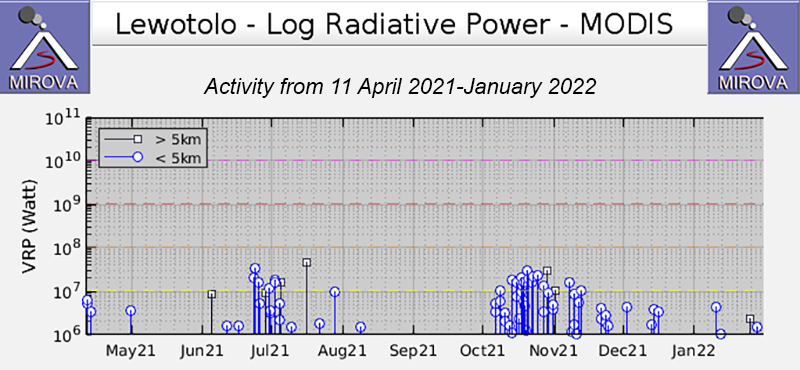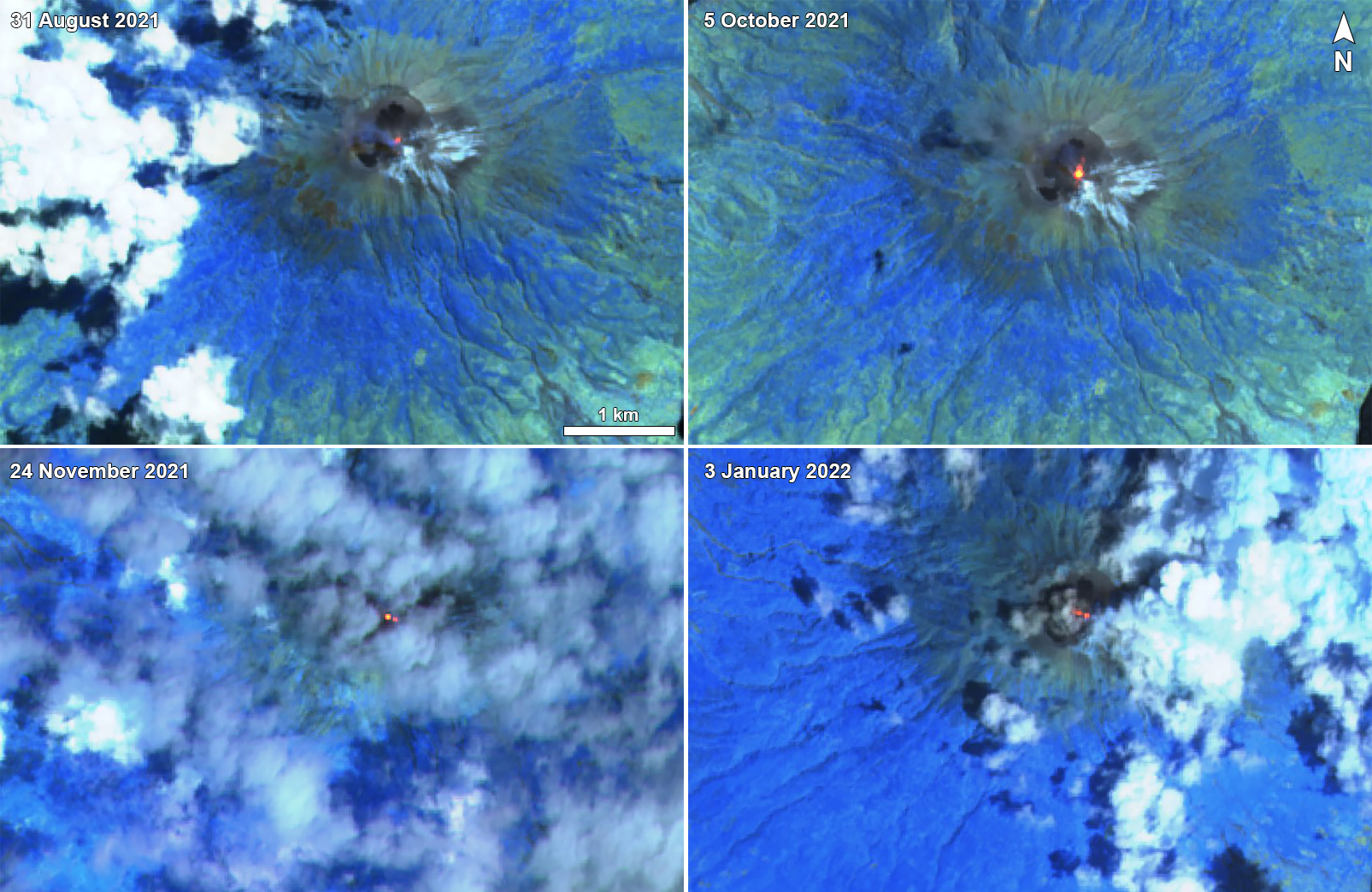Report on Lewotolok (Indonesia) — March 2022
Bulletin of the Global Volcanism Network, vol. 47, no. 3 (March 2022)
Managing Editor: Edward Venzke.
Edited by Kadie L. Bennis.
Lewotolok (Indonesia) Strombolian activity persisted with ash plumes during August 2021-January 2022
Please cite this report as:
Global Volcanism Program, 2022. Report on Lewotolok (Indonesia) (Bennis, K.L., and Venzke, E., eds.). Bulletin of the Global Volcanism Network, 47:3. Smithsonian Institution. https://doi.org/10.5479/si.GVP.BGVN202203-264230
Lewotolok
Indonesia
8.274°S, 123.508°E; summit elev. 1431 m
All times are local (unless otherwise noted)
Lewotolok (also known as Lewotolo) is located on the island of Lembata (Lomblen) in the Lesser Sunda Islands of Indonesia. The current eruption period began in late November 2020 and has been recently characterized by explosions with ash emissions rising up to 1.5 km above the summit and incandescent ejecta. A cone had formed in the summit crater over the SE rim, which contains a smaller crater. Intermittent thermal activity was also visible in satellite imagery according to MIROVA data, MODVOLC, and Sentinel-2 infrared data. This report covers similar explosive activity during August 2021 through January 2022 with information provided by Pusat Vulkanologi dan Mitigasi Bencana Geologi (PVMBG, also known as CVGHM, or the Center of Volcanology and Geological Hazard Mitigation), MAGMA Indonesia, and satellite data.
Intermittent ash plumes were reported rising to a maximum of 2.1 km above the summit; incandescent ejecta was also observed rising hundreds of meters above the summit and extending a similar distance from the crater. Thermal anomalies in MIROVA data indicated pulses of higher activity during late June to early July, and again in October through November (figure 27). Sentinel-2 infrared satellite imagery provided thermal and visual evidence of thermal activity inside the summit crater on multiple occasions (figure 28). According to data from the MODVOLC thermal algorithm, a total of eight hotspots were detected on 8, 13, 15, 17, 20, and 22 October, and 9 November.
Daily white, gray, and black emissions rose 50-2,000 m above the summit during August. Occasional banging noises were also reported. On 10 August an eruption at 0729 produced an ash plume that rose 1.5 km above the summit and drifted S (figure 29). Incandescent material was ejected 200-350 m radially from the summit and was accompanied by banging noises. Ash plumes on 11 and 13 August rose 2 km and 1 km above the summit, respectively, both of which drifted W. During 15-16 August incandescence was observed from the SW part of the crater. On 18 August an ash plume at 1820 rose 1 km above the summit and drifted W and material was ejected 500 m SE. Ash plumes rose 1.2-1.5 km above the summit and drifted generally W on 22, 24, and 26 August.
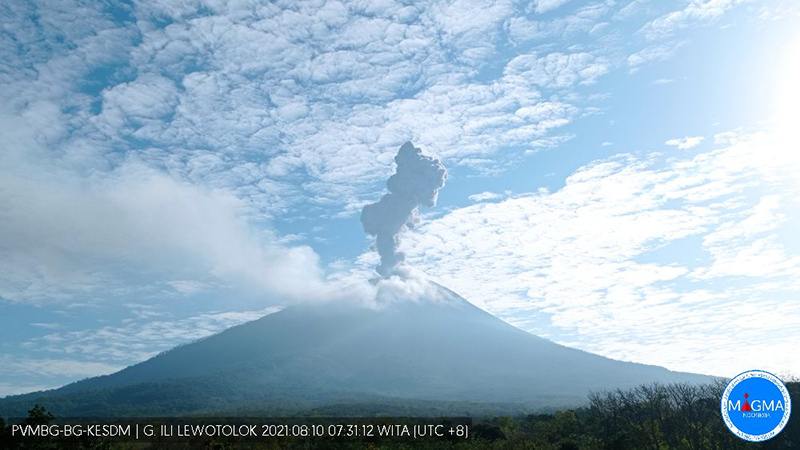 |
Figure 29. An ash plume rose 1.5 km above the summit of Lewotolok and drifted S on 10 August 2021. Courtesy of MAGMA Indonesia and PVMBG. |
Similar activity during September was characterized by daily white, gray, and black emissions rising 50-700 m above the summit. Ash plumes rose 200-600 m above the summit. Incandescent material was ejected as high as 300 m above the summit during 1-2 September. Some incandescent material traveled as far as 1 km to the SE on 5 September (figure 30). On 15 September an ash plume rose 600 m above the summit and during 15-16 September incandescent material was ejected 100-300 m above the summit to the E (figure 31). Crater incandescence was visible on 17 September, followed by incandescent ejecta as high as 300 m above the summit that was reported on 18, 19, and 21 September.
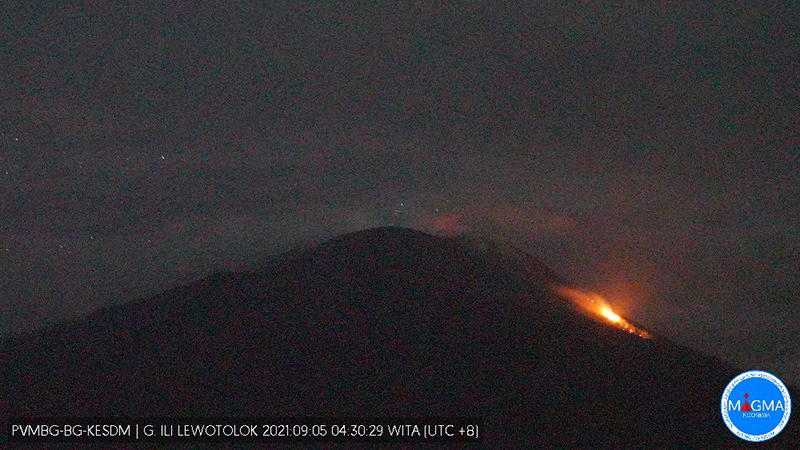 |
Figure 30. Incandescent material from Lewotolok traveled as far as 1 km to the SE on 5 September 2021. Courtesy of MAGMA Indonesia and PVMBG. |
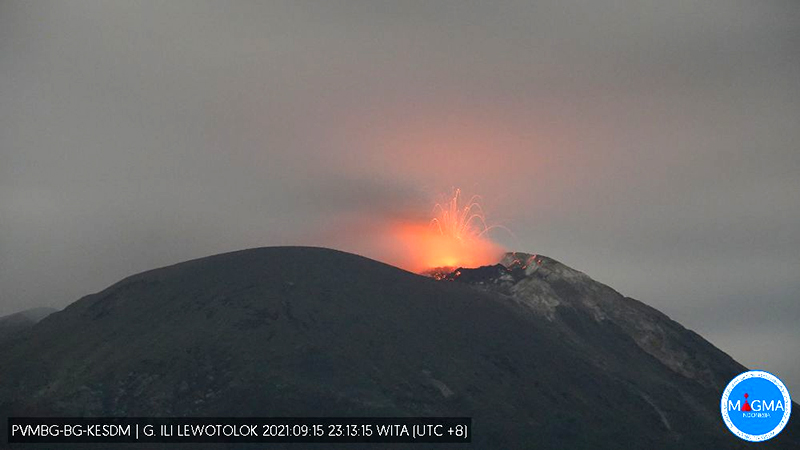 |
Figure 31. Incandescent material from Lewotolok was ejected 100-300 m above the summit to the E on 15 September 2021. Courtesy of MAGMA Indonesia and PVMBG. |
During October white, gray, and black emissions rose 50-1,000 m above the summit. Ash plumes were reported rising as high as 1 km above the summit. Rumbling and banging sounds were reported daily. On 1 October an ash plume rose 800 m above the summit and drifted W and incandescent ejecta during 1-2 October rose 300 m above the summit (figure 32). During 3-5 October incandescent material was ejected as far as 700 m from the vent in multiple directions. On 6 October material was ejected as far as 1 km to the SE and 300 m to the SW; an associated ash plume at 1723 rose 600 m above the summit. A VONA stated that on 7 October an ash plume rose 1.9 km above the summit and drifted W. Daily incandescent ejecta were detected during 8-16 October rising up to 300 m above the crater, one event of which moved to the SE. On 11 October there were 24 eruption events reported with ash emissions rising 200 m above the summit, and during 13-15 October there were a total of 77 eruption events with similar ash emissions up to 1 km above the summit. An ash plume at 0548 on 25 October rose 2.1 km above the summit. Incandescent pulses and weak rumbling sounds were reported on 30 October.
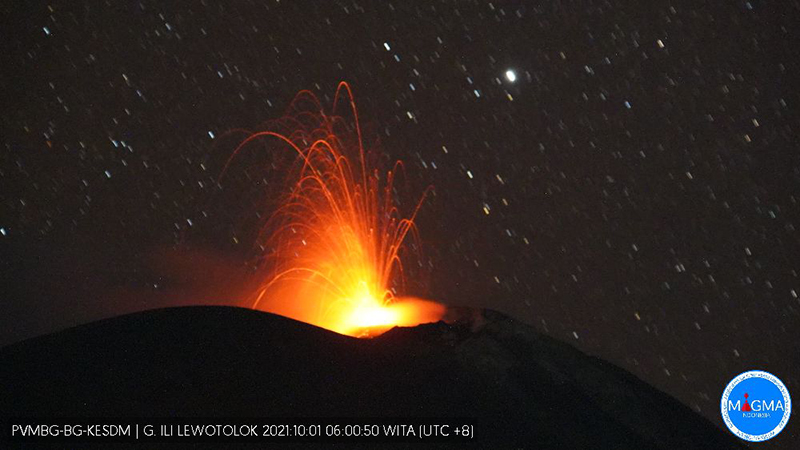 |
Figure 32. Incandescent ejecta rose as high as 300 m above the summit of Lewotolok on 1 October 2021. Courtesy of MAGMA Indonesia and PVMBG. |
White, gray, and black emissions persisted in November, rising 50-2,000 m above the summit. During 1-3 November incandescent material was ejected 100-200 m above the summit, and frequent rumbling and banging sounds were reported. On 6 October there were 16 eruption events that produced white and gray emissions 200-300 m above the summit; rock avalanches and crater incandescence were also observed (figure 33). Incandescent material was frequently ejected as far as 400 m away from the vent in multiple directions. During 19-20 November incandescent material was ejected 200 m E from the vent and crater incandescence remained visible during 22-30 November. On 24-25 and 30 November incandescent material was ejected 200-500 m above the summit to the E and SE.
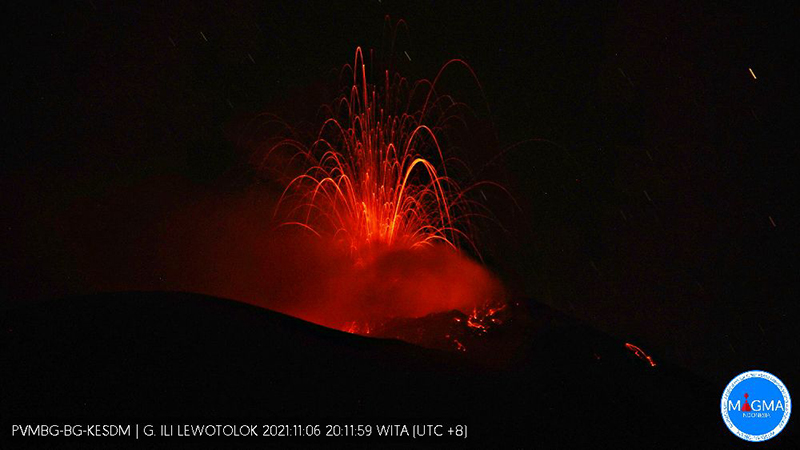 |
Figure 33. Incandescent material and rock avalanches were visible above the Lewotolok summit on 6 October 2021. Courtesy of MAGMA Indonesia and PVMBG. |
Activity continued during December, with white, gray, and black emissions rising 50-800 m above the summit. During 7-8 December incandescent material was ejected 300 m above the summit; faint rumbling accompanied this activity. On 13, 14, and 15 December ash plumes rose to 500 m, 700 m, and 600 m above the summit, respectively (figure 34). Incandescent material was ejected on multiple days during 15-29 December as high as 300 m in different directions. Ash plumes on 25 and 27 December rose 500 m and 400 m above the summit, respectively.
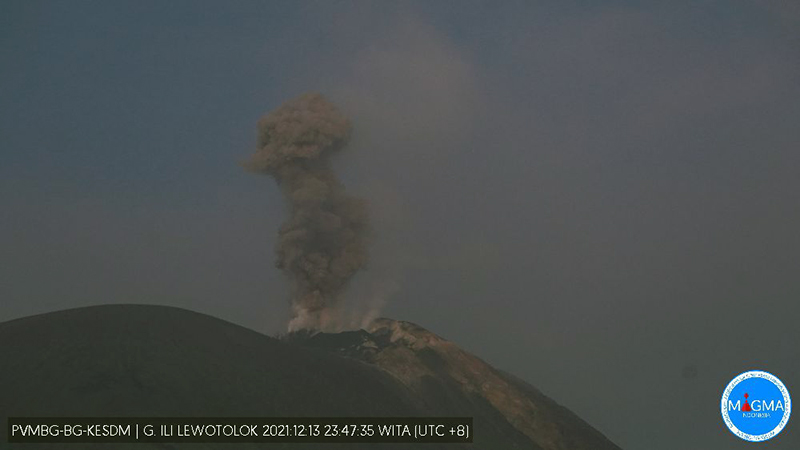 |
Figure 34. An ash plume rose 500 m above the summit of Lewotolok on 13 December 2021. Courtesy of MAGMA Indonesia and PVMBG. |
During January 2022, white, gray, and black emissions rose as high as 600 m above the summit and drifted E and SE and incandescent material was ejected 300 m from the vent, accompanied by rumbling. At 0848 on 11 January an ash plume rose 700 m above the summit and drifted E (figure 35). During 11-14 January ash plumes also rose as high as 700 m above the summit, drifting E, SE, and W.
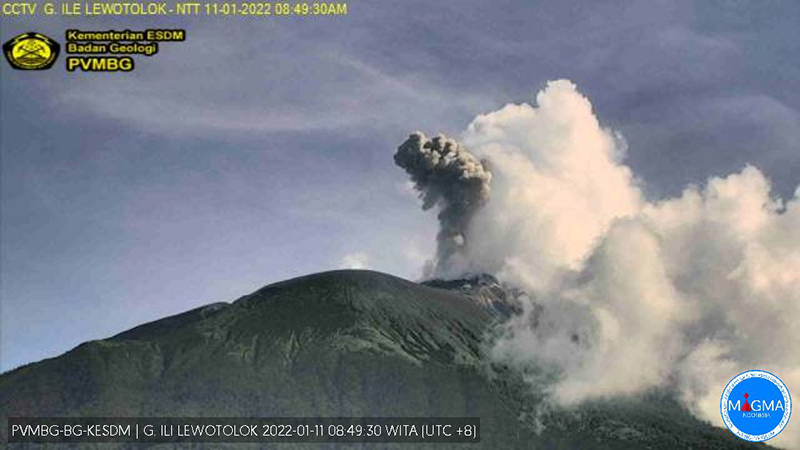 |
Figure 35. An ash plume rose 700 m above the summit and drifted E from Lewotolok on 11 January 2022. Courtesy of MAGMA Indonesia and PVMBG. |
Geological Summary. The Lewotolok (or Lewotolo) stratovolcano occupies the eastern end of an elongated peninsula extending north into the Flores Sea, connected to Lembata (formerly Lomblen) Island by a narrow isthmus. It is symmetrical when viewed from the north and east. A small cone with a 130-m-wide crater constructed at the SE side of a larger crater forms the volcano's high point. Many lava flows have reached the coastline. Eruptions recorded since 1660 have consisted of explosive activity from the summit crater.
Information Contacts: Pusat Vulkanologi dan Mitigasi Bencana Geologi (PVMBG, also known as Indonesian Center for Volcanology and Geological Hazard Mitigation, CVGHM), Jalan Diponegoro 57, Bandung 40122, Indonesia (URL: http://www.vsi.esdm.go.id/); MAGMA Indonesia, Kementerian Energi dan Sumber Daya Mineral (URL: https://magma.esdm.go.id/v1); MIROVA (Middle InfraRed Observation of Volcanic Activity), a collaborative project between the Universities of Turin and Florence (Italy) supported by the Centre for Volcanic Risk of the Italian Civil Protection Department (URL: http://www.mirovaweb.it/); Hawai'i Institute of Geophysics and Planetology (HIGP) - MODVOLC Thermal Alerts System, School of Ocean and Earth Science and Technology (SOEST), Univ. of Hawai'i, 2525 Correa Road, Honolulu, HI 96822, USA (URL: http://modis.higp.hawaii.edu/); Sentinel Hub Playground (URL: https://www.sentinel-hub.com/explore/sentinel-playground).


